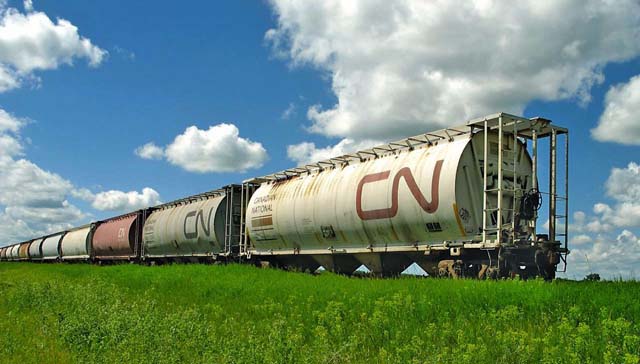
Risks and Benefits
Winnipeg Manitoba - A University of Manitoba agriculture economist warns regulations
cutting how much the railways are allowed to earn hauling grain could discourage them from investing
to be more efficient.
"I don't know if you want to mess with the system too much," Derek Brewin said in an
interview 23 May 2017.
"They've (western farmers) got a competitive rate (compared to northern U.S. farmers) and
they've got an incentive for the railways (under the current maximum revenue entitlement) to make
money and incentives to invest in grain movement."
Brewin was responding to calls by some farm groups that the federal government determine railways
costs for grain hauling before changing the maximum revenue entitlement (MRE) formula.
The MRE, implemented by the federal government in 2000, gives the railways the flexibility to set
freight rates to encourage grain shippers to be more efficient, more efficient shippers pay lower
rates.
However, the policy also protects farmers from the railways charging what the market will bear,
setting a limit on the total revenue railways can collect hauling western grain to export
ports.
The railways' annual grain shipping entitlements are based on a formula that in 1992, the last time
rail costs were reviewed, gave them a 20 percent contribution over variable costs.
Regulators believed it was fair and reflected what would occur in a competitive market.
Although the MRE is adjusted annually for inflation and the volume of grain and distance moved, the
railways have said it discourages investments.
Travacon, a consulting firm hired by four Saskatchewan farm groups, including the Saskatchewan Wheat
Development Commission, estimates in 2013-2014 the railways earned a 61 percent contribution because
of increased system efficiency.
"This was $322 million, or $8.36 a tonne, in excess of the contribution level of 20 percent
that was deemed fair and adequate under the Western Grain Transportation Act, and which Travacon
believes is the maximum that could be earned under effective competition," Travacon said in a
March 2015 study.
During the last election the Liberals promised a costing review before changes to the
MRE.
16 May 2017 the Liberal government introduced Bill C-49, the Transportion Modernization Act, which
proposes amendments and additions to the Canada Transportation Act to make grain shipping more
efficient.
It also proposes modifying the MRE to reflect individual railway investments, something grain
farmers, shippers, and the railways support.
However, Ottawa is mum on a costing review.
"Why would they ever invest again in improving their efficiencies if they are never going to be
able to capture any of those gains? It's a dangerous signal," Brewin said.
"I don't think that's a sustainable signal to send to the railways in the long
run."
A costing review is needed to make the right policy decisions, Sask Wheat general manager Harvey
Brooks, said in an interview 26 May 2017.
"We want profitable and thriving railways to maximize grain throughput, but we also want
producer protection from undue (railway) pricing," he said.
"We just want to know what is fair."
That extra $8 a tonne Travacon says railways are earning, could help pay for new hopper cars, he
said.
"I don't want the people managing the constraints (in the transportation system), benefiting
from the constraints," Brooks said.
The Western Grain Elevators Association, which supports keeping a modified MRE, wants Ottawa to
focus on making C-49 law, its executive director Wade Sobkowich, said in an interview
25 May 2017.
"Down the road if adjustments to the MRE are needed that's fine, but if you open that up now it
wouldn't be the right time," he said.
"To me it's not a slam dunk that a costing review would end up in reduced freight rates and
less costs paid by shippers and producers because you can't even imagine all the arguments the
railways are going to raise on the other side."
Allan Dawson.
of the Canadian Copyright Modernization Act.


